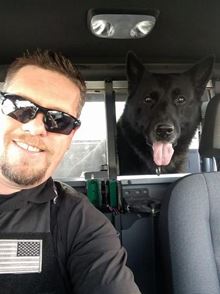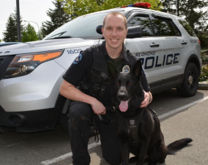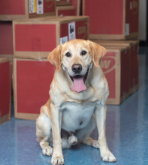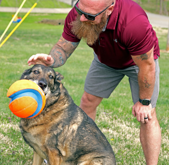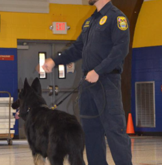Died – 11/20/18
Handler – Officer Dan Sanders
Town of Cedaredge pays its respects to K-9 officer
The first time Dan Sanders had to leave behind Buddy, it was harder on him than it was on the dog. Putting on the uniform, the bulletproof vest, getting in the patrol vehicle and going to work at the station were all things that included Buddy. They were partners and had each other’s backs. But Sanders, the Cedaredge police chief, realized Buddy needed to retire from his work as a K-9. The black German shepherd was going blind, felt the effects of a broken back from a work-related injury and couldn’t take on the bad guys anymore.It was time. The second time Sanders had to leave behind Buddy was no easier. A veterinarian’s house call last week made the decision for him. Though Buddy’s heart and lungs still sounded strong, he couldn’t get around, wasn’t getting up. When Sanders started as a young officer with the department 15 years ago, it was the promise of becoming a K-9 handler that attracted him to the job. He grew up in Delta County, went away to college, came back and earned his law enforcement certifications. Joining a smaller department, in a town with only one stoplight, for lower pay and less action than a metro police force wasn’t exactly a selling point.But Chief Tom Early told him if he came and worked for him, they’d figure out a way to get him a dog. A few years after he joined the department, Sanders acquired his first K-9, a German shorthair pointer named Jett, a narcotics and tracking dog who came from another agency. But that partnership ended in tragedy — Sanders only had Jett for one and a half years when he was killed after he ran into traffic and was hit by a school bus. Sanders wanted to bond with a dog he could train from the beginning, a puppy, and Early agreed to this if Sanders could raise the funds to buy one. Police K-9s come from specific bloodlines and training facilities and usually cost thousands of dollars. Sanders hit up the local Rotary Club and other service organizations for donations and even held a coin drive at the local schools, giving the winning students the honor of naming the dog.That’s how Buddy got his name, which Sanders hated at first. “I was a young, dumb cop, and I wanted a tough name,” he said. “But I loved it in the end.” It’s a small miracle they ended up together. He wasn’t even going to give Buddy a chance to try out for the gig, after he made his first impression. “As soon as he got out of the kennel, he threw up all over me,” Sanders said. “I did not want that dog.” Instead, he took one of Buddy’s sisters for a tryout, and she wasn’t a good fit. They just didn’t click. Neither did several other dogs. He returned to the training center two weeks later with Early, who pointed at the dog that barfed on Sanders and said, “Hey, we’ve gotta try this black one out.” Sanders reluctantly took Buddy for a trial run. Sure enough, they were a match. Buddy was responsive, social and confident, exactly what Sanders was looking for in the first police dog he would train from puppyhood. After eight weeks of training at the Rocky Mountain Canine Academy, there was no separating them. Like Sanders himself, Buddy was destined for the big city, but took a detour to this rural area and joined the drug task force spanning six counties. During his career, he found suspects and helped apprehend them, protected his fellow officers and nabbed drugs. For years, he was the only K-9 covering the sprawling 7th Judicial District, with mountain communities as far away as Lake City and Ouray. Sanders remembers one drug bust where Buddy searched a house after officers had already combed the property. He found 12 kilos of cocaine hidden in a drawer’s false compartment after the humans missed it. Eight years ago, Buddy helped apprehend a wanted suspect near Paonia after he tracked him down, swam across a river and attacked him in a tent. That’s how he injured his back, which resulted in major surgery to repair damaged vertebrae. Buddy flew in helicopters, helped in rescue operations and was fearless as long as he was by Sanders’ side. “He had a rock star life for a dog,” Sanders said. He grew into a gentle giant, and despite his training to attack suspects and bite when needed, Sanders never worried about him around his own boys, Keaton and Logan. Buddy understood when he was working and when he could play or just be a dog. “He’s just the friendliest dog you’d ever meet, until we’d tell him to be otherwise,” he said. “He could flip that switch faster than any other dog I’ve been around.” Buddy would have loved to keep going to work with Sanders, even though a genetic eye disease called pannus took his sight. Instead, he kept doing public relations, going to school groups and visiting kids who had saved pennies for him when they were in kindergarten and now were in middle school. He made the same rounds Sanders did when he campaigned to buy Buddy, raising money for the department’s new dog, K-9 Tigger. All Buddy knew was that his mom and dad and brothers were there with him, and he went to sleep. And after it was over, Sanders and his two sons carried Buddy outside to the car, and saw what was waiting for Buddy on his last ride. Police cruisers, ambulances and firetrucks lined the roadway, waiting to escort Buddy to his gravesite up the hill, outside town. They followed, with lights but no sirens, winding up the roadway to a chosen spot in the trees. The funeral procession took them seven miles above town to Sanders’ parents’ house. “Not all of them make it here, but the special ones make it to this spot,” he said. “It’s the family spot where our best dogs go.” Buddy is the first of the chief’s dogs to earn a place here. He received an escort of 20 vehicles, arranged without Sanders’ knowledge by those in the department and his wife, Amy, who had let the officers know she thought the veterinarian would probably say it was time to let Buddy go. They arranged the same escort that would be for any of their officers who had served with them, because he had. After they buried Buddy, Sanders came back down the mountain, haunted by the thought of leaving behind his partner, his friend, his family member and dog. “Dad, I never thought about it,” Sanders 9-year-old son, Logan, told him. “But he’s a policeman.” “Yes, he was,” he said.
